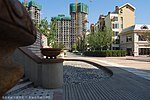Parts of this article (those related to demographic data are 10-16 years old) need to be updated. (September 2020) |
Langfang
廊坊市 | |
|---|---|
Clockwise from the top: Sanhe, Jingkelong, Beijing Daxing International Airport, Downtown Langfang at night | |
 | |
 Location of Langfang City jurisdiction in Hebei | |
| Coordinates (Langfang municipal government): 39°32′18″N 116°41′01″E / 39.5383°N 116.6835°E | |
| Country | People's Republic of China |
| Province | Hebei |
| Settled | 1948 |
| Established | September 13, 1988 |
| Municipal seat | Guangyang District |
| Area | |
| 6,417.28 km2 (2,477.73 sq mi) | |
| • Urban | 961.8 km2 (371.4 sq mi) |
| • Metro | 961.8 km2 (371.4 sq mi) |
| Population (2020 census)[1] | |
| 5,464,087 | |
| • Density | 850/km2 (2,200/sq mi) |
| • Urban | 1,147,591 |
| • Urban density | 1,200/km2 (3,100/sq mi) |
| • Metro | 1,147,591 |
| • Metro density | 1,200/km2 (3,100/sq mi) |
| GDP[2] | |
| • Prefecture-level city | CN¥ 281 billion US$ 42.7 billion |
| • Per capita | CN¥ 60,769 US$9,000 |
| Time zone | UTC+8 (China Standard) |
| ISO 3166 code | CN-HE-10 |
| License Plate Prefix | 冀R |
| Website | lf |
| Langfang | |||||||
|---|---|---|---|---|---|---|---|
| Simplified Chinese | 廊坊 | ||||||
| Literal meaning | "assistant minister's dwelling" | ||||||
| |||||||
Langfang is a prefecture-level city of Hebei Province, and was known as Tianjin Prefecture until 1973. It was renamed Langfang Prefecture after Tianjin became a municipality and finally upgraded into a prefecture-level city in 1988. Langfang is located approximately midway between Beijing and Tianjin. At the 2020 census, the population of Langfang was 5,464,087, of whom 1,147,591 lived in the built-up (or metro) area made of Guangyang and Anci districts; its total area is around 6,417.28 km2 (2,477.73 sq mi). [3]Langfang borders Baoding to the southwest, Cangzhou to the south (both prefecture-level cities of Hebei), Beijing to the north and Tianjin to the east. Sanhe City and Dachang Hui County are now conurbated with Beijing, so that they form part of the same built-up area. Langfang is the smallest prefecture-level city of Hebei Province by land area.[4]
- ^ "China: Hébĕi (Prefectures, Cities, Districts and Counties) - Population Statistics, Charts and Map".
- ^ 河北省统计局、国家统计局河北调查总队. 《河北经济年鉴-2018》. 中国统计出版社. ISBN 978-7-5356-7824-9. Archived from the original on 2020-03-26. Retrieved 2019-07-11.
- ^ "我市第七次全国人口普查主要数据发布 全市常住人口546.41万人 - 廊坊市人民政府". www3.lf.gov.cn. Retrieved 2024-10-25.
- ^ "城市综述_政府网群_廊坊_新华网河北频道". he.news.cn. Retrieved 2024-10-25.






